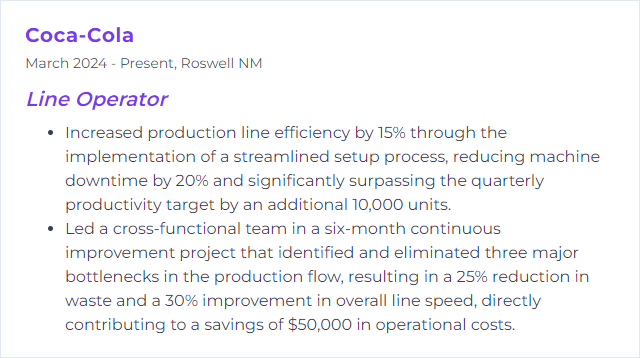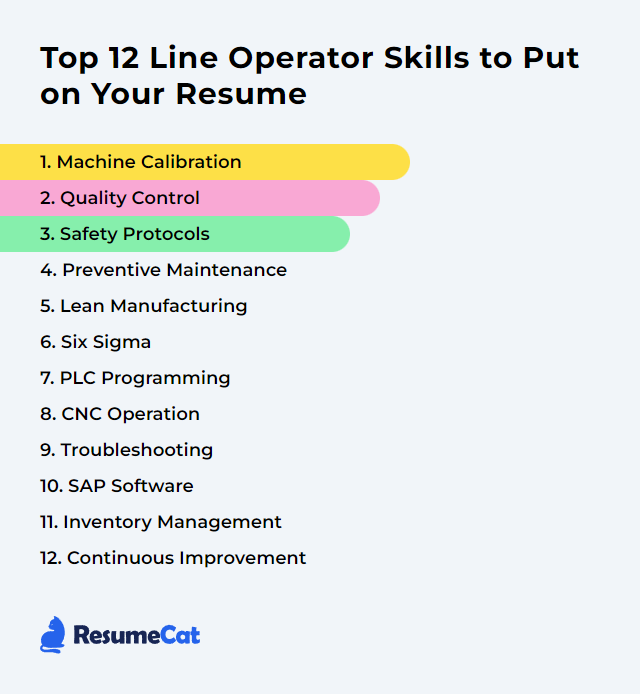Top 12 Line Operator Skills to Put on Your Resume
In the highly competitive manufacturing and production industries, a line operator's resume that showcases a robust set of skills can significantly enhance their job prospects. Highlighting the top 12 line operator skills on your resume not only demonstrates your capability to potential employers but also positions you as a valuable asset to their operations, making you stand out in a crowded field of candidates.
Line Operator Skills
- Machine Calibration
- Quality Control
- Safety Protocols
- Preventive Maintenance
- Lean Manufacturing
- Six Sigma
- PLC Programming
- CNC Operation
- Troubleshooting
- SAP Software
- Inventory Management
- Continuous Improvement
1. Machine Calibration
Machine calibration for a Line Operator involves adjusting and setting machinery to ensure it operates within specified parameters and produces products that meet quality and accuracy standards.
Why It's Important
Machine calibration is crucial for ensuring accurate and consistent production outcomes, minimizing errors, and maintaining product quality standards.
How to Improve Machine Calibration Skills
Improving machine calibration starts with keeping equipment accurate and steady. Try these steps tailored for a Line Operator:
Understand Your Machine: Read the manual to grasp calibration procedures and requirements.
Regular Checks: Schedule and perform routine calibration checks, even when the machine seems fine.
Use Correct Tools: Employ appropriate and recently calibrated tools for every adjustment.
Record Data: Keep detailed logs of calibration activities, deviations, and corrective actions.
Training: Stay current with training on new calibration techniques and equipment.
Control the Environment: Keep temperature and humidity within recommended ranges during calibration.
Seek Expertise: Consult the manufacturer or qualified technicians when results look off or inconsistent.
By following these steps, you can maintain the precision and reliability of your machinery, ensuring optimal operational performance.
How to Display Machine Calibration Skills on Your Resume
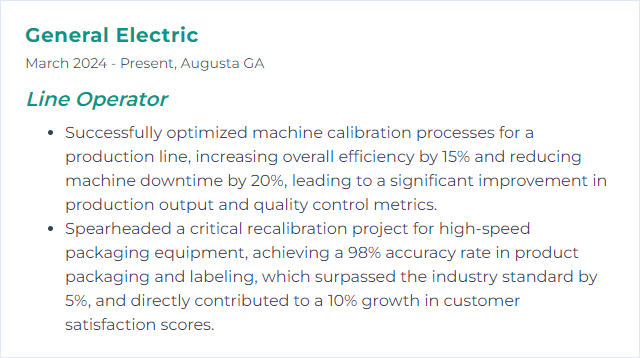
2. Quality Control
Quality control, in the context of a Line Operator, involves monitoring and adjusting the production process to ensure the final product meets predefined standards and specifications.
Why It's Important
Quality control is crucial for a Line Operator as it ensures the consistency and safety of products, minimizes waste and operational costs, and sustains customer satisfaction and trust.
How to Improve Quality Control Skills
Make quality a habit, not an afterthought. Focus on precision, consistency, and small daily improvements.
Understand Specifications: Know the product standards, tolerances, and acceptance criteria cold.
Regular Training: Refresh skills often; align with workplace safety and quality guidelines.
Use of Technology: Apply SPC software and measurement tools to monitor processes in real time.
Routine Maintenance: Keep equipment in spec; poorly maintained machines create defects.
Continuous Improvement: Adopt a Kaizen mindset—frequent, small changes that add up.
Quality Checks: Conduct frequent inspections and document results for traceability.
Feedback Loop: Capture issues quickly, communicate clearly, and correct at the source.
Each of these steps, when implemented diligently, can significantly improve the quality control process for a Line Operator.
How to Display Quality Control Skills on Your Resume

3. Safety Protocols
Safety protocols for a Line Operator are a set of guidelines and procedures designed to prevent accidents and injuries, ensuring a safe working environment around machinery and production lines. These include equipment handling, personal protective equipment (PPE) use, emergency response, and adherence to safety regulations.
Why It's Important
Safety protocols are crucial for a Line Operator as they minimize workplace hazards, prevent accidents and injuries, ensure compliance with regulations, and maintain a safe and efficient production environment.
How to Improve Safety Protocols Skills
Build a culture that treats safety as non‑negotiable. Keep it practical, visible, and enforced.
Assess Risks: Run thorough risk assessments to identify hazards specific to line operations.
Standardize Procedures: Create clear SOPs for all tasks, embedding safeguards and lockout/tagout steps.
Training: Deliver upfront and recurring training on equipment use, ergonomics, and emergency response.
Engage Employees: Involve operators in audits, safety huddles, and corrective actions; encourage no‑fault reporting.
PPE: Provide the right gear, enforce use, and replace damaged items immediately.
Regular Reviews: Update protocols after incidents, near misses, or process changes; verify effectiveness.
Emergency Preparedness: Drill scenarios—fires, chemical spills, equipment failures—until responses are second nature.
By systematically addressing these areas, line operators can significantly enhance their safety protocols, leading to a safer and more efficient workplace.
How to Display Safety Protocols Skills on Your Resume
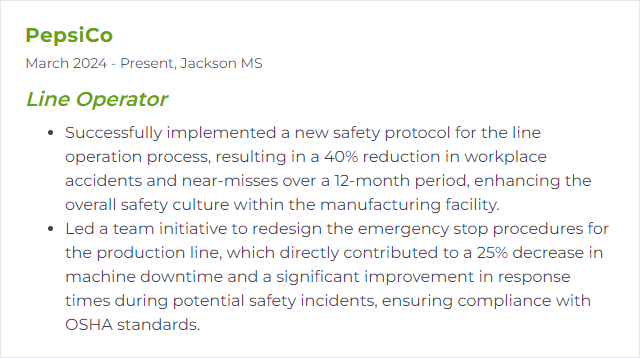
4. Preventive Maintenance
Preventive maintenance for a Line Operator involves regular, scheduled maintenance tasks on machinery and equipment to prevent unexpected breakdowns and ensure smooth operation, optimizing productivity and minimizing downtime.
Why It's Important
Preventive maintenance is crucial for a Line Operator as it ensures the smooth operation of machinery, minimizes unexpected downtime due to breakdowns, and extends the lifespan of equipment, ultimately saving time and reducing costs.
How to Improve Preventive Maintenance Skills
Keep machines healthy and surprises rare. Focus on structure, visibility, and learning from history.
Schedule Regular Inspections: Build an inspection cadence using OEM guidelines and failure history.
Use a CMMS or EAM: Automate work orders, track parts and labor, and log equipment history.
Train Operators: Teach basic care, early fault signs, and first‑level troubleshooting.
Predictive Techniques: Add vibration, temperature, and oil analysis where practical.
Spare Parts Readiness: Stock critical spares and set reorder points to cut downtime.
Review and Improve: Analyze PM results, update tasks, and retire non‑value checks.
By following these steps, Line Operators can significantly improve the effectiveness of their preventive maintenance routines, ensuring that equipment runs more reliably and efficiently.
How to Display Preventive Maintenance Skills on Your Resume
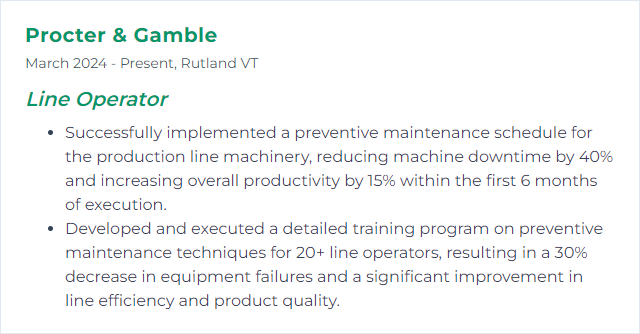
5. Lean Manufacturing
Lean Manufacturing is a systematic approach to reduce waste and improve efficiency in production processes, focusing on maximizing value for the customer by optimizing workflow and eliminating non-value-added activities. For a Line Operator, it means consistently working smarter, not harder, by following streamlined processes and actively participating in identifying and solving problems to keep the production line running smoothly and efficiently.
Why It's Important
Lean Manufacturing is important because it helps in reducing waste, improving quality, and increasing efficiency on the production line, directly contributing to smoother operations and a safer, more productive work environment for a Line Operator.
How to Improve Lean Manufacturing Skills
Make waste visible and flow obvious. Then chip away—every shift, every station.
Waste Reduction: Hunt the seven wastes and remove them; deploy 5S to keep the workspace sharp.
Continuous Improvement (Kaizen): Run frequent, small experiments and lock in wins.
Standardized Work: Create clear, best‑known methods to cut variation and boost repeatability.
Visual Management: Use Kanban, Andon, and clear status boards for instant at‑a‑glance control.
Teamwork and Communication: Share problems early; solve them together; spread what works.
For a Line Operator, focusing on these areas can significantly contribute to the efficiency and effectiveness of Lean Manufacturing practices in their day-to-day operations.
How to Display Lean Manufacturing Skills on Your Resume
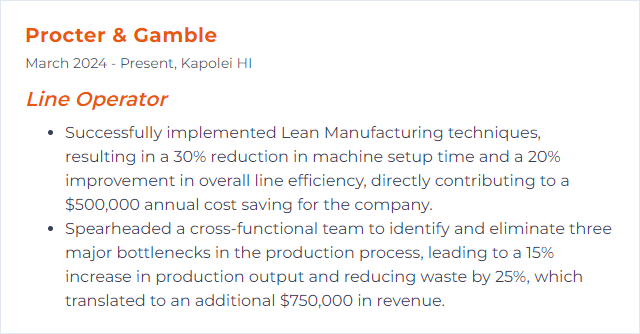
6. Six Sigma
Six Sigma is a set of techniques and tools aimed at improving processes by reducing errors and increasing quality, leading to better productivity and efficiency for line operators.
Why It's Important
Six Sigma is important for a Line Operator because it focuses on reducing errors, improving quality, and increasing efficiency in production processes, leading to higher customer satisfaction and cost savings.
How to Improve Six Sigma Skills
Think data, not hunches. Fix root causes, then keep the gains.
Know DMAIC: Define the problem, Measure current performance, Analyze causes, Improve the process, Control to sustain.
Quality Tools: Use Pareto charts, fishbone diagrams, and control charts to zero in on issues.
Standard Work + Error Proofing: Combine clear standards with poka‑yoke to prevent repeat mistakes.
Team Problem‑Solving: Join cross‑functional efforts; diversity of views speeds breakthroughs.
Blend with Lean: Remove waste while reducing variation for faster, steadier flow.
Close the Loop: Capture lessons learned and update procedures and training.
By focusing on these areas, a Line Operator can significantly contribute to enhancing Six Sigma processes within their operations.
How to Display Six Sigma Skills on Your Resume
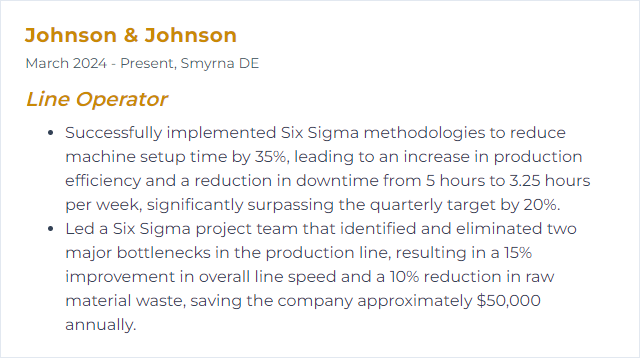
7. PLC Programming
PLC programming involves creating instructions for a Programmable Logic Controller (PLC) to automate machinery and processes on a production line. It helps in controlling equipment, ensuring precise operations, and enhancing efficiency.
Why It's Important
PLC programming is crucial for a Line Operator because it allows for the precise control and automation of machinery on the production line, ensuring efficient, safe, and consistent operations.
How to Improve PLC Programming Skills
Start simple, test often, and learn the hardware you’re driving.
Master the Basics: Learn ladder logic, function blocks, and structured text fundamentals.
Practice Real Scenarios: Build small programs that mimic on‑line problems and edge cases.
Study Manuals and Datasheets: Know your PLC family, I/O modules, and communication settings.
Use Simulation: Validate logic offline before pushing changes to live equipment.
Stay Current: Track firmware updates, programming environments, and device libraries.
Troubleshoot Fast: Read fault codes, watch scan times, and trend key tags to pinpoint issues.
Design for Safety: Follow safe states, interlocks, and locking routines; never bypass safeguards.
Peer Reviews: Share code for feedback; standardize naming and comments.
By focusing on these areas, a Line Operator can significantly improve their PLC programming skills, leading to more efficient and reliable system operations.
How to Display PLC Programming Skills on Your Resume
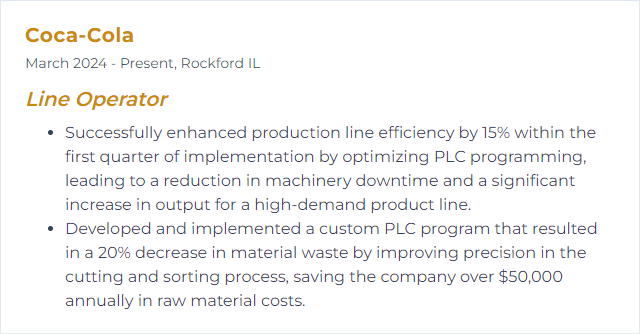
8. CNC Operation
CNC operation involves programming, setting up, and operating computer numerical control (CNC) machines to manufacture precision parts and components, ensuring adherence to specifications and quality standards. For a Line Operator, it typically means overseeing the production process, making adjustments as necessary, and ensuring the smooth functioning of the CNC equipment.
Why It's Important
CNC operation is crucial for a Line Operator because it ensures precision, efficiency, and repeatability in manufacturing processes, allowing for the production of high-quality parts with minimal waste and increased productivity.
How to Improve CNC Operation Skills
Chase accuracy first, speed second—then lock both in.
Regular Maintenance: Keep slides, spindles, and lubrication systems in spec; verify alignment.
Proper Tooling: Select the right tools and replace them at defined wear limits.
Optimize Cutting Parameters: Match speed, feed, and depth of cut to material, tool, and rigidity.
Quality Material: Inspect incoming stock; reject inconsistent batches early.
Software and Firmware: Update controllers and CAM posts after testing.
Training: Build skills in setup reduction, probing, and offsets; document best practices.
Safety: Guarding, chip management, and safe tool change procedures every time.
By focusing on these areas, a Line Operator can significantly improve CNC operation in terms of productivity, product quality, and safety.
How to Display CNC Operation Skills on Your Resume

9. Troubleshooting
Troubleshooting, in the context of a Line Operator, refers to the process of identifying, diagnosing, and resolving problems or malfunctions within a production line to ensure its smooth and efficient operation.
Why It's Important
Troubleshooting is crucial for a Line Operator as it enables quick identification and resolution of issues, ensuring the production line runs efficiently and minimally interrupted, thus maintaining productivity and product quality.
How to Improve Troubleshooting Skills
Be systematic, not frantic. Observe, isolate, test, and verify.
Learn the System: Know normal signals, cycle times, and setpoints; study manuals and schematics.
Define the Problem: Use the 5 Whys and evidence to get to root causes.
Plan the Fix: Prioritize actions by impact and safety; communicate the plan.
Implement and Test: Change one thing at a time; confirm the result before moving on.
Document: Record symptoms, causes, and fixes so the next occurrence is faster to resolve.
Keep Learning: Build electrical, mechanical, and controls literacy over time.
Sharpen Thinking: Practice logic and pattern recognition; review past incidents.
By methodically approaching problems, leveraging resources for learning, and continuously honing your skills, you can significantly improve your troubleshooting abilities as a Line Operator.
How to Display Troubleshooting Skills on Your Resume
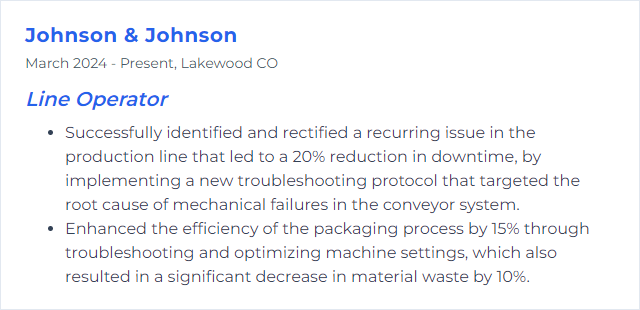
10. SAP Software
SAP software is an enterprise resource planning (ERP) system used to manage business operations and customer relations, streamlining processes such as inventory management, order processing, and financials for efficiency and real-time data access. For a Line Operator, it can help in scheduling production, monitoring equipment maintenance, and ensuring materials are available for production.
Why It's Important
SAP software is crucial for a Line Operator as it streamlines production processes, ensures timely access to critical data, and enhances operational efficiency, directly impacting productivity and decision-making on the factory floor.
How to Improve SAP Software Skills
Make SAP work for the operator, not the other way around.
Role‑Based Screens: Simplify the interface with task‑focused tiles and shortcuts.
Real‑Time Visibility: Connect shop‑floor data so KPIs, maintenance status, and material availability update instantly.
Targeted Training: Build short, scenario‑based guides and in‑app help aligned to daily tasks.
Automate Repetitive Steps: Use workflows and bots for routine confirmations and data entry.
Feedback Loops: Gather operator input regularly and iterate screens and processes based on that feedback.
By focusing on these areas, SAP software can become more intuitive, efficient, and valuable for Line Operators.
How to Display SAP Software Skills on Your Resume
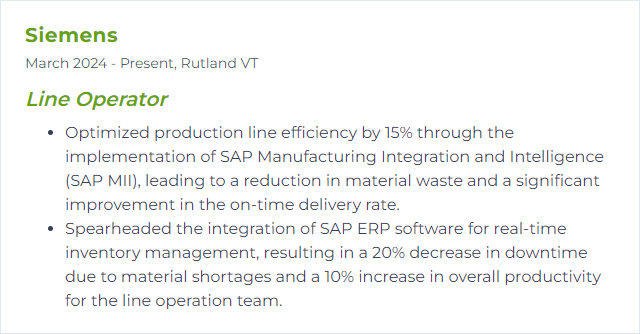
11. Inventory Management
Inventory management, in the context of a Line Operator, involves overseeing and controlling the supply, storage, and accessibility of components and materials required for production line operations, ensuring they are available as needed to maintain continuous and efficient production flow.
Why It's Important
Inventory management is crucial for a Line Operator as it ensures the timely availability of materials and parts required for production, minimizing downtime and maintaining consistent workflow for optimal efficiency and productivity.
How to Improve Inventory Management Skills
Keep counts tight and flow smooth—no stockouts, no bloated shelves.
Real‑Time Tracking: Use barcodes or RFID and frequent scans to keep data accurate.
Lean Inventory: Apply just‑in‑time principles where feasible to reduce excess.
Inventory Software: Forecast demand, set min/max levels, and automate reorders.
Cycle Counting: Audit small subsets often; correct discrepancies quickly.
Supplier Visibility: Share forecasts and lead times; confirm dates and quantities proactively.
Team Training: Standardize material handling, labeling, and variance reporting.
By implementing these strategies, a Line Operator can significantly contribute to more efficient and effective inventory management.
How to Display Inventory Management Skills on Your Resume
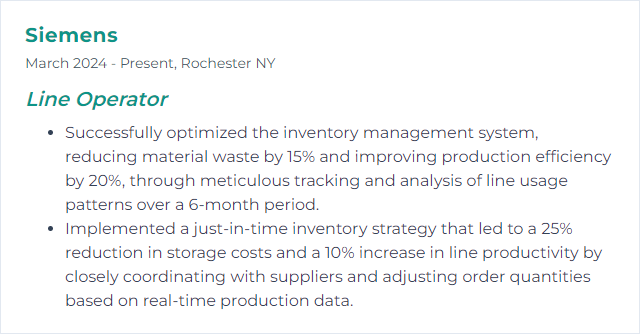
12. Continuous Improvement
Continuous Improvement, regarding a Line Operator, involves ongoing efforts to enhance processes, efficiency, and quality on the production line, aiming for incremental enhancements over time to optimize operations and reduce waste.
Why It's Important
Continuous improvement is crucial for a Line Operator as it enhances efficiency, reduces waste, and increases product quality, leading to higher customer satisfaction and better operational sustainability.
How to Improve Continuous Improvement Skills
Small wins, stacked daily, change everything.
Skill Building: Take short courses and on‑the‑job training tied to your equipment and process.
Feedback Rhythm: Hold quick retros and shift‑start huddles; surface problems without blame.
Leverage Technology: Use digital checklists, dashboards, and alerts to spot trends fast.
Kaizen Mindset: Run simple Plan‑Do‑Check‑Act cycles and standardize improvements.
5S Discipline: Sort, set in order, shine, standardize, sustain—repeat until it sticks.
By focusing on these areas, a Line Operator can significantly contribute to and enhance Continuous Improvement practices within their operations.
How to Display Continuous Improvement Skills on Your Resume
